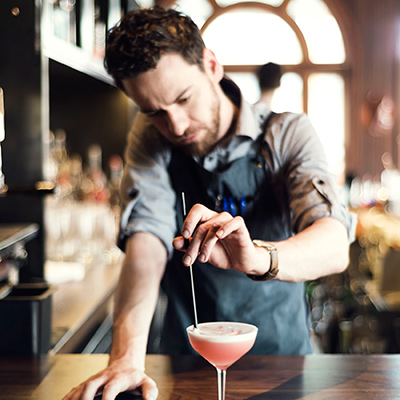Buying Cool: Wm. Mulherin’s Sons Reviewed

Woodfired oven at Wm. Mulherin’s Sons | Photo by Michael Persico
Wm. Mulherin’s Sons is the best-smelling restaurant I’ve been to all year.
It’s pretty, sure. Big, new, shiny, polished, fitted out with rich woods, artisan tile and carefully preserved architectural flourishes. But when you’re playing at this level, who isn’t pretty? Packaging matters. Every crack in the walls, every scuff on the floor or scab of tarnish on metal is as deliberate as the gleam on the walnut tables (as though the trees were grown to no other purpose than to be made into them, arranged in this order). There’s a big new skylight that lets brilliance spill in like water. The bar is long, brick-backed and achingly well stocked. The tall windows don’t rattle when the El snaps past, but you can feel it—roaring like a memory of dinosaurs and catching you right below the heart. This place has the design culture of second-gen hipsterism in its bones.
The weird name? It existed before the restaurant did. Before anyone who’s ever eaten here did. The building where Mulherin’s lives was once home to a 19th-century neighborhood whiskey rectifier, because of course it was. Because I guess no historical bowling alleys or abandoned shoe factories were on the market at just the right time. When Emily Teel (one of my most trusted culinary commandos) scouted it out early, she reported that it had “that particular Mumford & Sons aesthetic of a perfectly worn-in leather jacket,” and she was exactly right, provided we all agree and understand that the jacket got broken in by someone else. That Mulherin’s wears it now with the receipt from the vintage reseller still in the pocket. The place is so cool, it can be exhausting.
That smell, though …
If everything else skin-deep about Mulherin’s can be bought (has been bought), then the smell is different. That, you have to earn. It’s wood smoke from a well-ventilated pizza oven being put to the best possible use by a galley crew who can play it like a barroom piano. It’s yeast, alive and funky, and hot oil and garlic in the pan. It’s charred tomato and that sweet, almost grassy smell of onions being sweated and the heavy metallic tang of charring meat. On a good day, you can catch the smell of Mulherin’s from Frankford Avenue. Get much closer and it’ll lift you right off your feet and carry you straight through the doors like you’re a cartoon hobo smelling pie cooling on a windowsill. And the staff—the floor crew in their stripes and blue jeans—will be waiting for you.
“Here for dinner?”
“Absolutely.”
“Right this way.”
They’ll bring you bread to start. One of the large ninja army of servers who seem to appear and disappear at will delivering a plain white plate, a couple of slices, soft butter, nothing else. And you’ll think it’s the best bread in the city because, of course, you’re comfortable now, and the crowd is buzzing, filling up the bar and the tables, and the place smells so good and you’re starving.
It isn’t the best bread, but it’s close. A rustic sourdough, soft at the center, dense, with a deceptively tender crust that’s caught the smoke scent just like everything else. What it is is the bread that’s in front of you, and that counts for a lot. If it’d been awful or (almost worse) just dull, it would break the illusion of Wm. Mulherin’s Sons—the aura of practiced, polished, easy competence in which so much has been invested. The bread is the first taste anyone gets of what the kitchen can do, and it exists like a promise: We are at least this good. And this good? It’s pretty goddamn good.

Michael Haggerty mixes a Clover Club | Photo by Matthew Williams
Then the bar. Beers from a deep list. Wines by the glass and bottle. I order Clover Clubs because they’re hard to make well and easy to make terribly. The egg white, the competing sweetness of raspberry and lemon—so many of them taste like you’re drinking a summer-scented skin moisturizer. But not here, where they even sketch laurel leaves into the foam with the raspberry syrup. Such fillips wow the impressionable (like me) and those who are paying close enough attention to notice the small details the Mulherin’s team has so easily in hand. One night, I was in for dinner with my father-in-law. When he ordered a beer (an Oxbow Cavern, from the tap), the waitress warned it was sour. He asked how sour. She said pretty sour (meaning very) and offered a sample. In the meantime, she talked about the beer—just one off a list of many—like she knew it as a friend. And she did it without being pedantic, without spouting some corporate-approved beer-nerd spiel. “I love it,” she said, “but not everyone else does. You have to taste it and see if it’s your kind of thing.” She wanted to make sure it was right for him. That was what mattered. Which is impressive on a deeper level than any amount of cocktail art ever could be.
But if you want to really geek out, you have to pay attention to the kitchen’s game-day roster. It’s run by Starr Restaurants veteran Chris Painter, who closed his namesake (and Starr-branded) joint Il Pittore last year and jumped ship for Method Hospitality—the group behind Mulherin’s and an offshoot of the ROOST hotel brand. Il Pittore had issues. It was an odd place to eat, expensive and never really comfortable in the way it should have been. But the biggest problem might have been Painter himself—a pasta specialist in a city so full of pasta specialists that it’s hard to make a name for yourself without lighting your head on fire. He made beautiful, rustic plates of noodles so al dente that, against all odds, they became his trademark, but he still got lost in the wash of a dozen other great pasta makers and a hundred more who were merely very good. Nothing he ever did there really stood out unless you were in the room. Sit down at one of his tables and you immediately understood just how talented he was. The problem was convincing Philly crowds that his were the tables they ought to be sitting at.
Mulherin’s has no such troubles, because there are a dozen draws, not just one. There are still Painter’s pastas, of course (full of echoes of his best work at Il Pittore), but then there’s the place, and the neighborhood, too. The beer and the bar and the bread. There are split pork ribs stacked like Lincoln Logs in a shallow puddle of colatura with lime and pickled chilies, hamachi crudo sprinkled with crushed pistachios, veal tartare toasts with grilled baby lettuce, and braised veal cheek served over Roman gnocchi that are soft and rich, slicked with pork fat, and punctuated by the easy counterpoint of spring garlic and peas. The grill crew bangs out massive porterhouse steaks for two, tomahawk pork chops with horseradish and apple, a hanger steak, and a half chicken, bricked hard, grill-marked, and served on its own cutting board with escarole, pine nuts, cipollini onions and split cherries.

Spicy Jawn Pizza | Emily Teel
And then there’s the pizza team—the cooks who keep that wood-burning oven fed. They’re trained and overseen by Jonah Fliegelman and Nathan Winkler-Rhodes from Pitruco Pizza who run a pizza truck and have come here to sling beautiful, smoky, authentic pies and learn about running a restaurant without wheels. All of which means that in one kitchen, Mulherin’s has assembled a supergroup of mercenary Italian pros—the Traveling Wilburys of the carbohydrate universe.
And the result? Friday-night bourbon and a Spicy Jawn pizza—a flamethrower pie with hot coppa, pepperoni and sliced long hots gentled (barely) by a little caciocavallo and tomato sweetness, plus the funk of a good sharp provolone. It’s beautiful, that pie, the crust blistered, crisp and chewy all at the same time. And it isn’t even as good as the next one I have, a couple of days later.
Painter changes up his pasta menu regularly, rolling out specials as though even the eight on his board aren’t enough to contain all the possibilities rattling around in his brain. I eat pig’s head tortelloni—little envelopes, perfectly stiff, in a sauce made of the pig’s cooking liquid spiked with rosemary, black pepper, orange juice and zest—and cavatelli with porcinis and a creamy taleggio fonduta. The pappardelle noodles are thick and rough, ribboned onto the plate with sliced disks of young asparagus and a thick cap of parmesan. The corzetti is made with the meat from whole rabbits, turned into sausage, in a reduced blonde stock made from their bones, plus some fava beans and parmesan. Over and over again, the plates of pasta are restrained and delicious, complex in ways that have you chasing flavors to the bottom of the dish, not wondering at their unnecessary convolutions. There’s an honest, homey rusticity to them—even to the artsy drags of ricotta on the messinesi, the careful placement of hand-torn basil leaves, the snowfall of parm. Nothing contrived at all.
And when, early on a Sunday night, I follow the smell of wood smoke into the dining room, to a table pressed into a corner (because Mulherin’s is already busy, crowded with neighbors and friends), and ask for gin and a double margherita pizza with buffalo mozzarella, basil, perfect sweet tomato sauce and blobs of soft burrata half melted from the heat, what arrives is one of the best pies in the city. The crust is remarkable—tender and crisp-edged, leopard-spotted like it’s posing for a Lucky Peach cover shot, chewy at its heart and perfumed so deeply with that smoke that even the smell of it seems to have weight. The toppings are simple, but so ideal. The burrata adds a smooth creaminess to every bite, an additional level of texture that elevates traditional margherita to another level. If the pizza I had on that Sunday (along with the cavatelli, the tortelloni, and a plate of dates wrapped in prosciutto, stuffed with gorgonzola, baked until the skin of them cracks under the teeth, and then served with a thick plum purée) isn’t the best in the city, it’s very close. I’ve had maybe two or three better during the past five years of Philly’s crazy-ass pizza renaissance, and even that judgment is debatable. Mulherin’s pizzas, right now, are the definition of what modern traditionalism should taste like: a considered combination of contemporary flavors and the collected knowledge of hundreds of years of culinary refinement.
As a matter of fact, the same can be said for the restaurant as a whole. I had moments at Mulherin’s that rivaled the best I’ve had in any Philly restaurant lately. The first bite of that double margherita, the surprise of the tortelloni, the crowded, pulsing hum of the dining room on a Friday night when it feels like everyone in the city has just discovered it for the first time—the entire place exists at this carefully chosen crossroads between the modern and the traditional, the deliberately hip and the effortlessly brilliant. It brings together talents that complement without overshadowing each other, and a floor staff that exudes smart confidence and calm. They’re walking the walk because they recognize what we do—exactly how fortunate they are to be here, at this moment, in a place where everything is working so right.
3 stars – Come from anywhere in the city.
Wm. Mulherin’s Sons [Foobooz]


